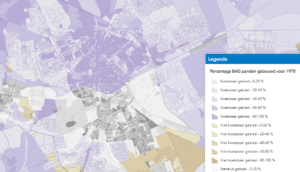Foundation problems in Groningen
It is estimated by the KCAF that about half a million homes in the Netherlands face or may face foundation problems. This does not yet include the influence of climate effects.
The KCAF (knowledge center addressing foundation problems) is the point of contact when it comes to reporting and consulting on vulnerable foundation.
Groningen, a province known for its vast landscapes and rich history, has faced an additional serious problem in recent years: foundation damage. This is mainly due to earthquakes resulting from years of gas extraction. These quakes resulted in a lot of damage to homes both externally (think cracks in the facades) and internally (sagging floors and bleeding in the floor). In addition, the subsidence of the soil is a big problem according to a study by TU Delft, this happens in some places in Groningen by 5mm per year. Over the years, this provides
In this blog, we cover the vulnerable areas and factors associated with them. In addition, we want to make you aware of the consequences of a damaged foundation and what you can do about it.
Which houses in Groningen get foundation problems?
To determine which houses in Groningen may have foundation problems, several areas of concern have been identified. With the “vulnerable foundation” interactive map from the Atlas Environment, you can see for yourself if your home is also in a vulnerable area.

The areas mapped involve an overview of sensitive area, urban area and non-sensitive area. Whether a foundation is vulnerable depends on several factors which can make your foundation more vulnerable such as:
- Location: Homes located in the immediate vicinity of gas extraction areas, such as the region around Loppersum, Siddeburen, Appingedam, and Ten Boer, have a higher risk of earthquake damage.
- Age: Older houses, especially those built before 1970, are often more vulnerable because they are built to be less earthquake resistant. These homes usually do not have deep foundations or foundation systems designed to withstand seismic activity.
- Foundation type: Houses with foundations on steel (shallow foundations) are more susceptible to subsidence and cracking due to vibration and landslides. Houses with pile foundations can also experience problems, especially if the wooden piles start to rot or if concrete piles crack due to soil movement.
- Soil type: Soil conditions in Groningen vary, but peat and clay soils are particularly susceptible to subsidence and movement. Houses built on these soils are at greater risk of foundation problems.
- Maintenance and construction quality: Homes that are poorly maintained or built with inferior materials are more likely to suffer damage. This includes houses that had pre-existing structural weaknesses before the earthquakes began.
How do you recognize foundation damage?
It is important to identify foundation damage in time. This way you avoid violent damages that build up over time. Foundation damage can be detected in and around your home in a variety of ways. Such are:
- Cracks in walls and ceilings
- Uneven or sagging floors
- Difficult to open doors and windows
- Visible cracks in the foundation
- Dampness, mold, and water accumulation around the foundation
- Cracks in the exterior facade
- Sagging in the garden or driveway
- Crooked chimneys indicate problems
Some of the above features will be consequences of gas production and earthquakes in the province. But this is not the only harm caused. Thus, a new threat has emerged namely: Japanese Knotweed in Groningen. This invasive exotic species spreads very quickly and can also invade the foundation of your home. The result is a weakening and room for moisture to invade.
There have been plans from the KCAF to make a foundation label mandatory with every appraised home. For the purchase and sale of your home, this label would provide a means of understanding the stability and durability of the foundation. These plans have not been pursued as yet.
What can you do about damaged foundation in Groningen?
To repair foundation damage, start with a thorough inspection by a certified structural engineer or foundation specialist to determine the extent and cause of the damage. In Groningen there are subsidies available that can be claimed by the homeowner this subsidy is as compensation for the mining damage experienced. This amount was initially €5,000 and has now been expanded to €10,000. To be entitled to this grant, the visible damage will have to be recorded in your home. This can be done at the earthquake damage instituation.
In earthquake-prone areas such as Groningen, seismic strengthening may be required, such as by installing seismic dampers. In addition, it is important to improve water management around the house to prevent future subsidence.
Repairing the foundation is an expensive operation and can vary from €1500 to €2000 per m2 for an entire house the cost can thus reach €100,000. Damage to your foundation is not covered by the Municipality of Groningen with the exception of Woltersum.
To conclude
Foundation problems pose a serious threat to the stability and safety of your homes in Groningen, caused by earthquakes and subsidence of the ground due to gas extraction. Especially with older homes, specific foundation types, and certain soil types such as peat and clay soils, there is an increased risk of foundation damage. Timely recognition of damage, such as cracks in walls, sagging floors and hard-to-open doors, is crucial to preventing further damage. In addition to earthquakes, the invasive Japanese Knotweed poses a new threat. Despite the availability of grants for restoration, the cost can be significant, sometimes as high as €100,000. A thorough inspection by a specialist is essential, as are measures for seismic strengthening and improved water management to prevent future subsidence.






